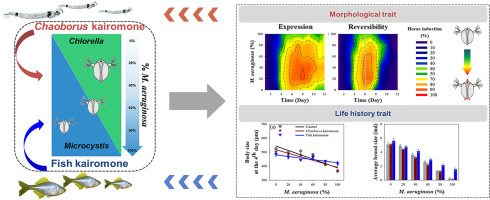Environmental Pollution ( IF 7.6 ) Pub Date : 2020-01-08 , DOI: 10.1016/j.envpol.2020.113952 Lei Gu 1 , Shanshan Qin 1 , Shuangshuang Zhu 1 , Na Lu 1 , Yunfei Sun 1 , Lu Zhang 1 , Yuan Huang 1 , Kai Lyu 1 , Yafen Chen 2 , Zhou Yang 1

|
Cyanobacterial blooms are an increasing problem in a more eutrophic world. It is still a challenge to fully understand the influence of cyanobacteria on the interactions between predator and prey at higher trophic levels. The present study was mainly undertaken to understand the inducible anti-predator responses of cladocerans while using cyanobacteria as part of food. Specifically speaking, we focused on the anti-predator strategies of Ceriodaphnia cornuta in response to different predators (fish and Chaoborus larvae) under food with different proportions of Microcystis aeruginosa. The morphological (i.e., body size and the induction of horns) and life history traits (e.g., time to first reproduction, offspring number, and survival time) responses were measured under different proportions of M. aeruginosa (i.e., 0%, 20%, 40%, 60%, 80%, and 100%). Our results showed that both the life history and the inducible anti-predator responses of C. cornuta were significantly affected by different concentrations of M. aeruginosa. Specifically, lower concentrations of Microcystis (20%–60%) can significantly promote the horns induction under Chaoborus predation risks, and higher Microcystis concentrations (60%–100%) tend to enhance reproduction in response to fish predation risks, such as larger body size, decreased time to first reproduction, and increased total offspring number. Additionally, an increasing concentration of M. aeruginosa decreased the ability of C. cornuta to reverse horns when predation risks removed. Our findings indicated that cyanobacteria affecting life history traits and the subsequent indirect effects on anti-predator responses in cladocerans could impact the interactions between predator and prey at higher trophic levels and may consequently contribute to shaping the structure of the community in a cyanobacteria bloom area.
中文翻译:

铜绿微囊藻影响角色尾藻的诱导性抗捕食者反应。
在富营养化的世界中,蓝藻水华是一个日益严重的问题。充分了解蓝细菌对营养水平较高的捕食者与猎物之间相互作用的影响仍然是一个挑战。本研究的主要目的是了解在使用蓝细菌作为食物的一部分时,锁骨的诱导性抗捕食者反应。具体而言,我们重点的反捕食策略网纹枸骨因应不同的天敌(鱼和Chaoborus幼虫)根据食物的不同比例的铜绿微囊藻。在铜绿假单胞菌的不同比例(即0%,20%)下测量形态学(即,体型和角的诱导)和生活史特征(例如,初次繁殖的时间,后代数目和存活时间)响应。,40%,60%,80%和100%)。我们的研究结果表明,铜绿假单胞菌的不同浓度均显着影响角膜梭菌的生活史和诱导型抗捕食者反应。具体而言,在潮虫捕食风险下,较低浓度的微囊藻(20%–60%)可以显着促进角诱导,而较高的微囊藻浓度较高(60%–100%)的人趋于提高对鱼类捕食风险的繁殖能力,例如更大的体型,减少的首次繁殖时间和增加的后代总数。另外,当消除捕食风险时,铜绿假单胞菌浓度的增加降低了角果衣原体逆转角的能力。我们的研究结果表明,蓝藻影响生活史特征以及随后对锁骨中抗捕食者反应的间接影响可能会影响较高营养水平下的捕食者与猎物之间的相互作用,因此可能有助于塑造蓝细菌开花区的群落结构。











































 京公网安备 11010802027423号
京公网安备 11010802027423号